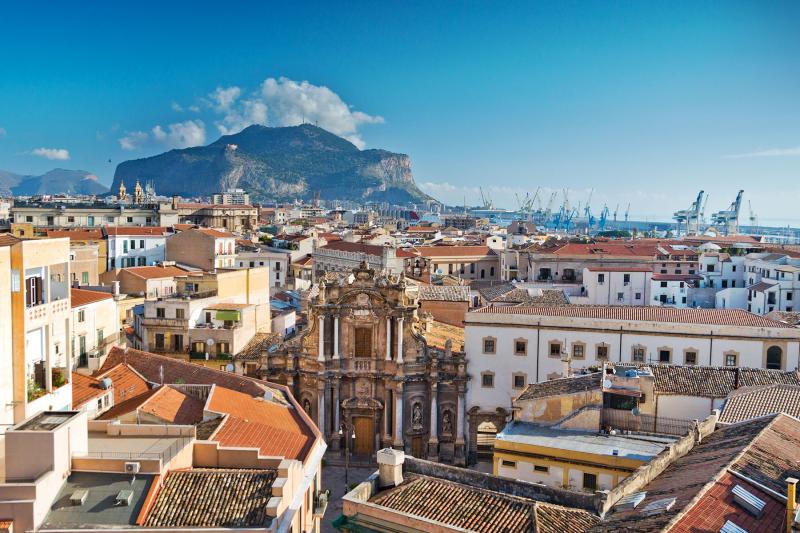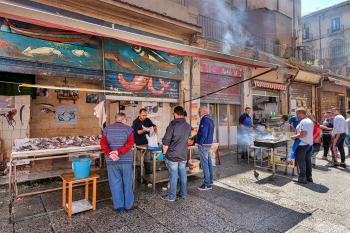Sicilian surprises in Palermo
Appears in the Online Edition, December 2018.
One thing I enjoy about my work is getting my outdated impressions back up to date. Europe is always changing -- and recently I discovered that Sicily's capital of Palermo has become a whole new city since my last visit. It's cleaner, safer and more efficient than it was in years past. But it still retains its colorful edge -- and that's why I love it.
Over the last decade, Palermo has revitalized itself with new museums, gentrified neighborhoods, pedestrianized streets and upscale shops and hotels. The Mafia's influence has also significantly diminished. Sure, the traffic is a free-for-all, and even the city's prettiest public spaces are rough around the edges. It's like Naples in that regard -- but most visitors come to appreciate Palermo's grittiness and what locals call its "bella chaos."
The heart of the city is Quattro Canti ("Four Corners"). It's where two main streets -- Via Maqueda and Via Vittorio Emanuele -- intersect, dividing the city into four major historical neighborhoods. Between the streets are four Baroque facades, each adorned with three tiers of statues. The bottom statues represent the four seasons, from a young maiden for spring to an elderly woman for winter.
A few steps from Quattro Canti is a trio of glorious churches, facing each other across Piazza Bellini: La Martorana, with gorgeous gilded mosaics; San Cataldo, filling a former mosque; and the highlight -- the Church of Santa Caterina, where a simple exterior hides an explosive Sicilian Baroque interior.
Nearby, in Piazza Pretoria, the famous "Fountain of Shame" is one of the few Renaissance works here. Its gathering of marble statues includes gods, goddesses and grotesques on several tiers, with the virgin goddess of hunt, Diana, presiding above the commotion. The nickname comes from the nude figures -- considered quite racy in conservative Sicily.
While Palermo can seem a bit ramshackle, behind its gritty walls hide exquisite noble mansions reminding visitors of the island's rich heritage. One of my favorite places to sneak a glimpse of aristocratic life is Palazzo Conte Federico, an elegant and extremely lived-in mansion built upon the city wall. Count Federico's family has lived here for centuries, and the current count is a race-car enthusiast (though after he flipped his car in a Sicilian road race, the countess said, "No more racing"). Tours of the mansion are led by their sons.
Perhaps the most fascinating sight is about 1.5 miles from the center, in a crypt below a Capuchin monastery. The Capuchins, a branch of the Franciscan order, have a passion for reminding people of their mortality. Historically, when their monastic brothers died, their bones were saved and put on display. The Capuchins of Palermo took this tradition a step further, preserving bodies in their entirety.
Inside the Catacombs of the Capuchins, a maze of corridors contains about 2,000 clothed skeletons and mummies: monks in brown robes, women wearing favorite dresses, priests in their vestments, soldiers still in uniform and children looking almost as if they are just taking a long nap. The oldest body -- Brother Silvestro -- has been hanging here since 1599. These "bodies without souls" are meant to remind the living that their time on earth is transitory, and something much greater awaits. If you believe in God, this crypt is actually a beautiful celebration of life. At the very least, it's a thought-provoking reminder of your mortality.
Palermo became a major city after the ninth-century arrival of the Arabs, who were the first inhabitants to spur the city's development. In the 11th century, the Normans, arriving from northern France, conquered and re-Christianized Sicily. Yet the Arab influence lives on throughout the city.
A great example is at the Palatine Chapel, built in the 12th century inside the Norman rulers' royal residence. The king at the time hired architects and craftsmen from different communities, and together they built a simple Norman structure with Arab-style arches and geometric designs, and then adorned the walls and ceiling with shimmering Norman-Byzantine mosaics.
Arab influence is also felt in Palermo's street markets, where merchants retain the tradition of singing their sales pitches. My favorite place to witness this is the Ballarò Market, the city's oldest, most authentic and liveliest market. And the Vucciria, with just a smattering of meat, fish and produce vendors, has one of the city's best street food scenes -- a one-stop shop for boiled octopus, spleen sandwiches and Sicily's famous fried rice balls (arancine).
While the Vucciria neighborhood is lively in the morning, it's even better after hours. Make it a point to explore its characteristic back lanes at night, where you'll likely stumble onto a wonderfully convivial scene under the stars -- a kaleidoscope of edgy graffiti, cheap plastic chairs, soccer on the big screen, big-eyed kids with gelato and people embracing life with Sicilian gusto.
IF YOU VISIT...
SLEEPING: Eurostars Centrale Palace, located just steps from Quattro Canti, offers 104 elegant rooms in a former noble palace (splurge, www.eurostarscentralepalace.com). AdHoc Rooms, just a stone's throw from Piazza Bellini, has five themed rooms, such as music, comics and sports (budget, www.adhocrooms.it).
EATING: Casa del Brodo, just steps from the Vucciria Market scene, is a Palermo institution (Corso Vittorio Emanuele 175, www.casadelbrodo.it). Bisso Bistrot, filling a former bookstore tucked just behind one of the Quattro Canti fountains, serves traditional Sicilian dishes in a homey, Old World interior (Via Maqueda 172a, www.bissobistrot.it).
GETTING AROUND: Though Palermo's main sights are mostly walkable, you can also ride the free shuttle bus that runs through the historic center. For sights farther away, buses and taxis are a good option.
TOURIST INFORMATION: https://turismo.comune.palermo.it.
(Rick Steves (www.ricksteves.com) writes European travel guidebooks and hosts travel shows on public television and public radio. Email him at rick@ricksteves.com and follow his blog on Facebook.)


